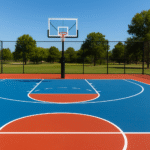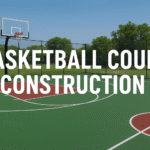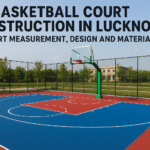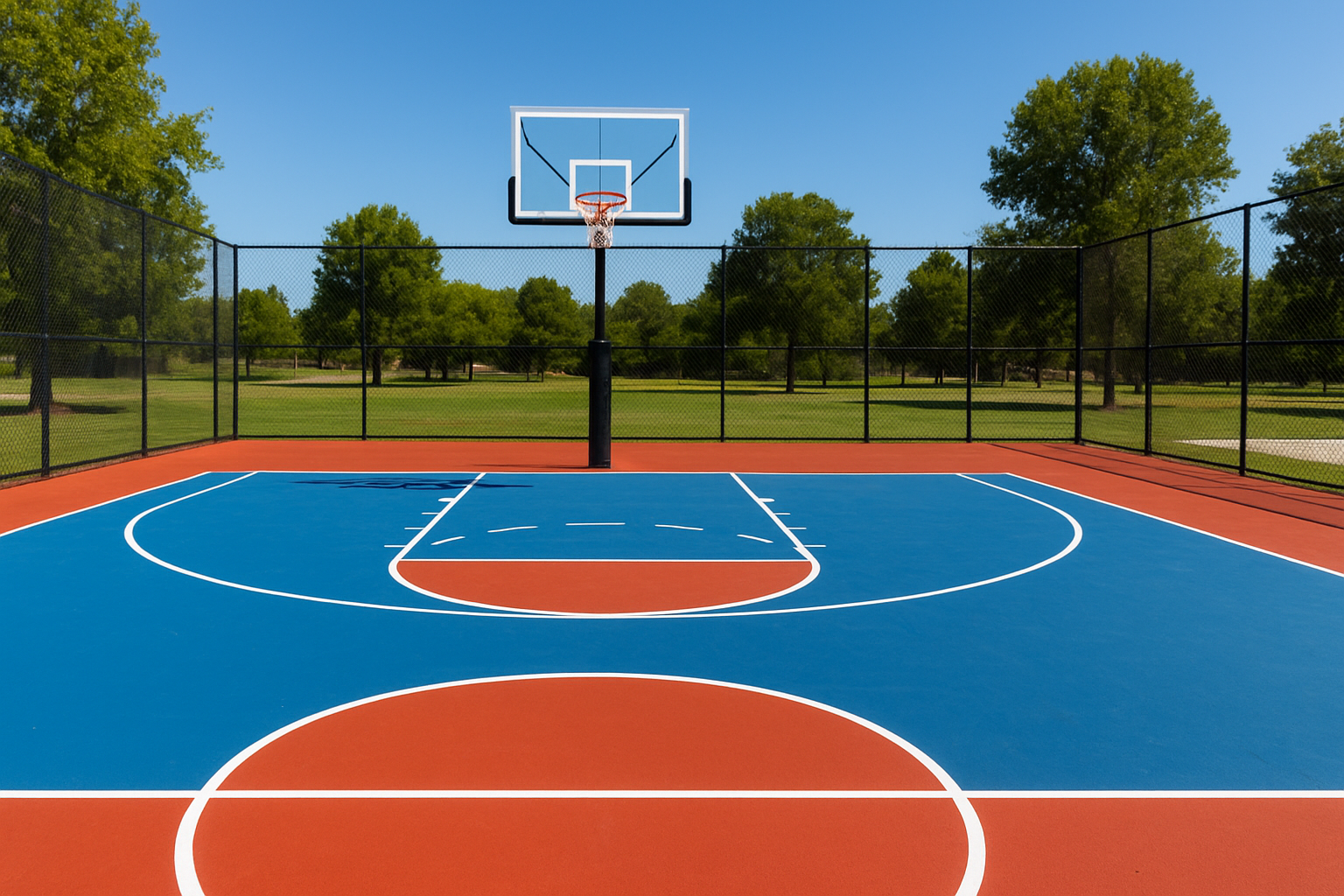Why build a basketball court in India?
Basketball court construction in India — from school playgrounds to dedicated academies. Why? It’s cheap to run (compared with many sports), inclusive, and a great youth development tool. Whether you’re a school, club, housing society, or municipality, a court is a community magnet: kids, weekend pick-up games, local tournaments, and training camps. Think of a court as a stage —Provide a good one and people will come perform.
Standards & dimensions: what to follow
FIBA standard court & buffer
A regulation international (FIBA) court has an inner playing area of 28.0 m × 15.0 m. Around that you must leave a safety boundary — FIBA recommends at least 2.0 m all around, producing a minimum total area of roughly 32.0 m × 19.0 m for the full zone. These clearances matter for player safety and official matches. Basketball court construction in India.
Key markings
- Center circle radius: 1.80 m.
- Three-point arc (FIBA): 6.75 m (main arc).
- Line width: typically 50 mm (5 cm) for main markings.
- Rim height: 3.05 m (10 ft) from the playing surface.
These are in the FIBA rules and should be used when building a competitive court.
Ceiling / clearance
For indoor courts, FIBA requires a minimum unobstructed height of 7.0 m above the playing surface; for major broadcast-quality arenas a clearance of 14.0 m or more is recommended. If you’re planning local games or school use, 7–8 m may be sufficient — but if you dream of hosting big competitions, plan higher.
Indoor vs Outdoor courts — pick your fighter
Indoor courts
- Pros: Better ball bounce (wood), year-round play, controlled lighting and drainage, premium look for schools/clubs.
- Cons: Higher construction and maintenance cost (airspace, HVAC, expensive hardwood).
Use indoor if you’ll host tournaments, run an academy, or want the best playing surface.
Outdoor courts
- Pros: Cost-effective, easier to install, durable with the right surface (acrylic/tiles).
- Cons: Weather exposure shortens life if low-cost finishes are chosen; drainage is crucial.
Outdoor acrylic or interlocking tiles are common for Indian climates.
Surface & flooring options
Your choice defines play, budget, and maintenance.
Basketball court construction in India – Wooden sprung floors (indoor)
The gold standard — maple or engineered timber on a sprung sub-frame provides excellent shock absorption and consistent bounce. Best for professional academies and indoor halls. Expect higher initial cost and periodic sanding/refinishing.
Polyurethane (PU) / poured PU
A seamless synthetic poured onto a properly prepared base. PU gives good shock absorption, uniform play and can be tailored for indoor/outdoor use. Many government tenders specify PU or UV-stable synthetic systems for durability and rebound.
Acrylic coatings (outdoor)
Common for outdoor courts — acrylic paint systems over asphalt or concrete provide good grip and weather resistance. They’re cost-effective but need recoating every few years depending on wear and India’s monsoon exposure. Contractor pages in India often list acrylic courts as a popular option.
Interlocking polypropylene tiles
Modular tiles snap together, are quick to install, provide shock absorption, and allow water to drain. Great for multi-sport playgrounds, community courts, and temporary events. Prices vary widely based on quality and UV rating.
Base, slab and drainage — the unseen foundation
Basketball court construction in India – Concrete slab thickness & reinforcement
A durable court typically rests on a concrete slab of 100 mm (4″) minimum; some projects opt for 125–150 mm (5–6″) in heavy-use or variable soil conditions. Reinforcing mesh and perimeter dowels/thickened edges are standard. A flat, well-cured slab prevents cracks and bad bounce. Aim for proper curing and control joints to reduce random cracking.
Drainage slopes & best practice
Outdoor courts must shed water. Industry guidance points to a minimum slope of about 1% (≈1 in 100) across the court for reliable drainage — many builders target 1–2% depending on site. Don’t make your court a puddle magnet.
Sub-base & compaction
Compact the subgrade and install a granular sub-base (crushed rock or engineered fill) under the slab to prevent uneven settlement. Soil tests and a structural engineer’s input are worth the small extra cost — they save a lot later.
Hoops, backboards & equipment
Rims & backboards
Use FIBA-approved equipment for official venues; rim height is 3.05 m (10 ft) and backboards are standardized in size and mounting. For training centers, adjustable or portable systems may be ideal. For permanent courts, in-ground anchored systems are safer and more stable.
Portable vs in-ground
Portable systems are flexible and cheaper up front; in-ground systems are sturdier for heavy use and tournaments. Choose according to usage frequency and budget.
Lighting, seating & ancillary infrastructure
lux levels
Lighting depends on use:
- Recreational/training: ~200–300 lux.
- Regional/national competition: 500–750 lux.
- International/TV broadcast: 1500–2000 lux with strict uniformity and vertical illuminance specs. If you plan broadcasts or professional events, invest in a proper LED system meeting FIBA’s detailed lighting guidance.
Spectator seating & safety buffer
Keep the 2 m buffer around the playing area clear (FIBA guidance). Fencing, spectator benches, and player benches should not encroach the safety area. Provide well-marked entry/exit routes for players and spectators.
Permits, approvals & sport bodies in India
Local permissions
Check your local municipal / development authority rules (setback, flood, noise). For public/municipal projects you’ll likely need building permits, electrical and plumbing (if lights/changing rooms) approvals.
SAI, BFI & government specs
Basketball court construction in India , SAI publishes design handbooks and models for multipurpose halls; the Basketball Federation of India (BFI) is the sport body to consult for tournament-standard features. Government tenders (GEM) often include specific technical specs for synthetic courts — these documents give exact material, rebound and temperature tolerance requirements to meet procurement terms.
Project cost & budgeting
Cost breakdown (typical items)
- Site prep & sub-grade: earthworks, compaction, base material
- Concrete slab & reinforcement or asphalt base
- Surfacing: wood / PU / acrylic / interlocking tiles
- Markings, hoops, backboards and accessories
- Lighting, fencing, seating, drainage
- Maintenance & warranties
Typical price ranges in India
Costs vary wildly by material and finish. For a quick reality check: recent industry estimates place indoor courts from roughly ₹290–₹1,580 per sq ft depending on finish and wood/PU choices, while outdoor synthetic/acrylic courts typically range lower (some contractors quote ₹120–₹350 per sq ft for acrylic systems). These are ballpark figures — site, shipping, foundation and equipment change the story. Always get 3 quotes and check references.
Step-by-step construction process
1. Site survey & design
Measure, soil test, set elevations, and choose orientation (preferably long axis N–S to reduce sun glare). Plan drainage paths.
2. Earthworks & sub-base
Excavate, compact, place granular fill and set forms.
3. Concrete/asphalt base
Pour slab (min 100 mm typical), use reinforcement, control joints and proper curing time.
4. Surface system installation
Install your chosen system (tiles, PU pour, wood sub-floor + timber, or acrylic coats over prepared slab). Each system has manufacturer-specific prep — follow instructions.
5. Markings & equipment
Paint lines, install hoops/backboards, nets, scoreboards, and safety padding as required.
6. Lighting & fencing
Install LED lighting to spec, mount poles, set fences, gates, and spectator seating.
7. Commissioning & testing
Bounce tests, line checks, lighting lux measurements, and final sign-offs.
Typical timeline: small outdoor court (4–6 weeks), large indoor conversion or stadium-quality floor (3–6 months) — depends on approvals, material lead times and curing windows.
Maintenance, warranty & lifecycle
- Acrylic outdoor courts: recoating every 3–7 years depending on play and weather.
- PU floors: periodic topcoat refreshes; 7–12 years typical before major works.
- Wood floors: sanding & refinishing every 7–10 years depending on wear.
- Keep surface clean, manage water run-off, check expansion joints, and inspect hoops/backboards annually. Manufacturers usually offer warranties — read what’s covered (materials only vs. installation). For government procurement, tender docs often require performance guarantees and specific test results (e.g., rebound rate). Government e Marketplace
Common mistakes & how to avoid them
- Skipping soil tests — leads to uneven settlement.
- Bad drainage/slope — court ponds after monsoon.
- Cheap base + premium surfacing — surface cracks if slab moves.
- Ignoring lighting and clearances — poor play and unusable for events.
- No maintenance plan — early rework and added cost.
Fix these by investing in a proper base, hiring experienced contractors, and insisting on warranties and testing.
Quick checklist & sample timeline
Owner checklist before handover
- Flatness & bounce tests passed
- Proper line markings & correct dimensions
- Lighting lux report provided
- Equipment installation (hoops/boards) verified
- Drainage tested after a rain simulation
- Maintenance manual & warranties handed over
Sample timeline (outdoor acrylic)
- Week 1–2: site prep & sub-base
- Week 3: concrete slab & curing (may require 7–21 days depending on mix)
- Week 4: priming & acrylic layer system installation
- Week 5: line marking, equipment install, inspection
Real-world examples & India-specific notes
Government tenders and SAI specifications increasingly favor UV-stable synthetic systems (PU or polypropylene tiles) with strict technical parameters (temperature tolerance, rebound rate, and UV resistance). If bidding on public projects, review GEM and local SAI documents for mandatory clauses (many include required test values and product life expectations).
Conclusion
basketball court construction in India is a very doable project — whether it’s a simple neighborhood outdoor court or a full indoor academy-grade facility. The keys are: get the base right, pick the right surface for your use and climate, follow the standards for safety and dimensions, and budget realistically. Treat the project like building a house for the ball: the consistent bounce, the cleanness of lines, and the safety buffer all hinge on careful planning and good materials. Want to host games, build community, or start an academy? Start with a clear brief, consult SAI/BFI references if needed, and hire reputable contractors.
FAQs
1. What are the exact FIBA court dimensions I should use?
The FIBA playing court is 28.0 m width and 15.0 m lenth with at least 2.0 m of boundary around it (for a total minimum area of about 32.0 m × 19.0 m). Use FIBA rules for official competitions.
2. How much does it cost to build a basketball court in India?
Costs vary by surface and scope: outdoor acrylic/interlocking courts can start from roughly ₹120–₹350/sq ft, while indoor PU or wood floors can cost significantly more (estimates vary widely — ₹290–₹1,580/sq ft depending on finish and extras). Always get multiple quotes.
3. ss is recommended for outdoor courts?
A common standard is 100 mm (4″) minimum; heavier-use courts sometimes use 125–150 mm and extra reinforcement. Proper compaction and controlled joints are essential.
4. Do outdoor courts need a slope? How much?
Yes — provide drainage. Aim for ~1% slope (1 in 100) across the court to prevent water pooling; some designs use 1–2% depending on site conditions.
5. Which surface lasts longest with low maintenance in India’s climate?
High-quality polyurethane (PU) systems and well-manufactured interlocking tiles with UV-stable material tend to offer durability with moderate maintenance. Acrylic paints work well but need recoating more frequently because of sun and rain. Government specs often favor UV-resistant synthetics for longevity.




